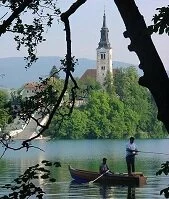Culture & Identity of Slovenia
Introduction

Fishing
Slovenia is a country where the simple rural life meets the modern age. The people seem to be very knowledgeable of the world around them and enjoy seeing the world, but always seem to settle back home, whether that is the city of Ljubljana or a village in the Alps.
Half the people in Slovenia live in an urban setting and half live in more rural areas. However, the capital is the only true city in the country as most of the other cities are smaller. No matter the location, the people seem to be a part of a larger community and there is no shortage of friendliness.
Although the people are very down to earth and kind, they also work hard and for most working people, the daily way of life revolves around their work schedule or kids' school hours. Most people with regular working hours arrive to work at about 8:00 am and return home at about 5:00 pm. In rural settings it's common for an extended lunch break, but this depends on the industry and location.